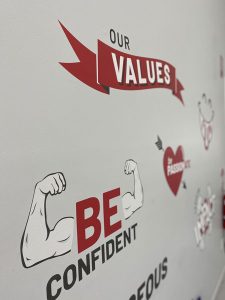If you’ve followed us in the past, or had a logo design meeting at Brand Hero HQ, you might have heard us talk about the components of a brand – the elements that go into a brand that will attract customers and repel others.
We see a brand like a person. And like a person, a brand is composed of key elements that when combined together, make something unique.
 Visual Identity
Visual Identity
This is like a person’s haircut and sense of fashion. It is elements like your company logo, business cards, website design and signage.
Communication
This is like a person’s way of speaking, writing and communicating to others. The way a company communicates on social media and how its website content is written is an example of this.
Values & Mission
Like a person, a brand will also have a set of beliefs and principles. A company’s core values and mission statement are indicative on how it goes about its business.
These three elements combine together to create your brand. And ideally, this unique combination will help attract the right people to your business and the wrong people away from your business.
What are corporate values and why do they matter?
Having a strong and relatable set of corporate values enables your team to get on the same page about a common purpose and mission to strive towards. They help communicate a certain level of behaviours that are expected of them that will lead to success, both for them and your customers.
It also enables your brand to appear consistent to external parties. If everyone is acting and behaving in a similar way, this is a reflection of strong brand values that help build your brand and its culture.
But I am not here to educate you how to create values for your company. There are many people out there who are much more qualified than I in this field. If you’re looking for the development of your organisation’s values and mission, here is a good starting point.
How to effectively communicate your company values to your team
Lead by example
Leading by example is a great way for a company to effectively communicate its values. If the team members see the leadership and management living and breathing the core values, they are much more likely to take ownership and emulate these values also. For instance, if being respectful of others is a core value, having the team’s leader act this way will help the other team members get on the same page and mimic this.

Communicate regularly
Tell stories to your team and how the company’s values relate to every day in the office. This could be of a team member displaying the values and what that brought to the company. Repetition brings reward.
Use visual aids
Don’t keep your core values hidden in an internal document, gathering dust. Display them throughout the workplace with colourful wall graphics, pull-up banners and posters. Have them listed on the back of their ID cards, put in on your website and include it in any new employee induction documents. The more they see it and hear it, the more they feel it and respond.
Hold workshops or events
Come together as a team to explore the values and what they mean. This could be a values-specific workshop, or even an external team outing with a fun element incorporated. Show examples of the expected behaviours around these values and how it affects the brand.
No one method will help your team come to grips with your company’s values. It is a constant effort from all to develop these and foster them within an organisation. Yet, it is an effort worth undertaking and an effective way to build the more subtle aspects of your company’s brand.
